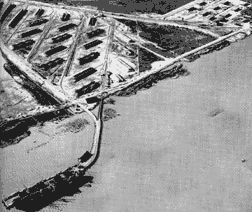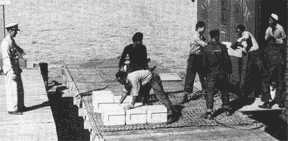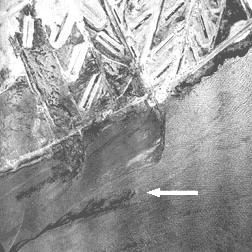 |
| Pier at Port Chicago before the explosion. Lower left, one ship at dock. At the upper left are the concrete revetments or barriers which protected boxcars. At upper right are the barracks about one mile from the pier. |
Port Chicago Disaster - July 17, 1944
During World War II, one of the sources of ammunition for the Pacific Theater was the Naval Ammunition Depot at Port Chicago, California. Port Chicago is located on an arm of San Francisco Bay about 30 miles northeast of Oakland and San Francisco. The town of Port Chicago, population 1,500, was located about 1.5 miles from the pier. Not far away was Vallejo's Mare Island, a major Naval Base which included ammunition depots.
Construction of the depot was authorized on December 9, 1941, just 2 days after Pearl Harbor and started operation began in November 1942. The site was used as a shipyard during World War I and was served by the Santa Fe, Southern Pacific, and Western Pacific railways.
Most of the ammunition arrived by train from Hawthorne, Nevada, where it was made, was held in boxcars "parked" between protective concrete barriers, and when needed, the train was moved onto the pier which accommodated 2 ships. About a mile from the pier were barracks which housed the African-American ammunition handlers.
 |
| Pier at Port Chicago before the explosion. Lower left, one ship at dock. At the upper left are the concrete revetments or barriers which protected boxcars. At upper right are the barracks about one mile from the pier. |
African-Americans in the Navy
After World War I, the Navy tried to exclude African-Americans, replacing their ranks with Filipinos. In 1932, the Navy again recruited blacks, but they were limited in numbers and confined to menial tasks, primarily as messmen (kitchen helpers). There were no black officers.In 1942, the Navy reluctantly accepted blacks for general service, but in segregated units which did not include sea duty. At Port Chicago at the time of the disaster there were 1,400 black enlisted men, 71 officers, 106 marine guards, and 230 civilian employees.
Loading went on 24 hours per day. The men moved the ammunition hand-to-hand, on hand trucks, or carts, or rolled larger bombs down a ramp from the boxcars which were right on the pier and placed them into cargo netting which they spread out on the pier.
 |
| African-American Navy enlisted men unloading ammunition from boxcar onto cargo netting, while white officer supervises. |
The ammo included small caliber bullets, incendiary bombs, fragmentation bombs, depth charges, and bombs up to 2,000 pounds. The cargo nets were lowered by the ships booms into a hatch, where they were packed layer by layer and secured with dunnage (scrap wood).
Neither the officers nor the men received any training in handling ammunition. There was tremendous pressure to speed up the loading and officers made bets on the quantity of ammunition their unit would load in an 8 hour shift. The men were speeded up by threats of punishment. It was backbreaking, dangerous work.
The Explosion
On the evening of July 17, 1944 there were two ships being loaded at the pier. The Liberty ship SS E.A. Bryan, after 4 days of loading, had about 4,600 tons of ammunition and explosives on board; 98 black enlisted men continued work. On board the ship were 31 U.S. Merchant Marine crew and 13 Naval Armed Guard.Docked at the pier since 6 PM that evening was the SS Quinault Victory being loaded by about 100 black men for its maiden voyage. On board were 36 crew and 17 Armed Guard. A Coast Guard fire barge was also moored at the pier. Besides 430 tons of bombs waiting to be loaded, the pier held a locomotive and 16 boxcars with its crew of three civilians, and a marine sentry.
At 10:18 an Army Air Force plane flying at 9,000 feet saw pieces of white hot metal, some as large as a house, fly straight up past them. According to the co-pilot, the "fireworks display" lasted about one minute. The explosion was heard 200 miles away.
The Miahelo, a Coast Guard patrol boat, was about 1,500 feet from the pier. The force of the explosion wrecked the wheelhouse, nearly capsized the boat, badly wounded the man at the wheel; and was followed by a 30 foot wall of water. A 16 inch shell, which did not explode, hit the engine room of a small tanker, the SS Redline which was passing nearby.
The 1,200 foot long wooden pier, the locomotive and boxcars, the SS E.A. Bryan, and 320 people (202 black enlisted men) on the pier were gone. All 67 crew and 30 Armed Guard aboard the two ships died instantly. Of the 390 military and civilians injured, which included men in the barracks and townspeople, 233 were black enlisted men.
There were no identifiable pieces of the SS E.A. Bryan remaining: 25,000,000 pounds of ship and ammunition were gone! Disappeared! The stern of the SS Quinault Victory lay upside down in the water 500 from its origin. The rest of the ship, which had been lifted clear out of the water and turned around, was in scattered pieces.

The wreckage of the SS Quinault Victory. The darker object at the far right is the propeller. The photo below shows the pier after the explosion. There is no sign of the SS E.A. Bryan, the arrow points to the wreckage of the SS Quinault Victory, beyond which there is an oil slick.

No cause for the explosion was ever determined.
The black ammunition handlers, many of whom had quietly voiced concerns about safety, feared loading ammunition again. Fifty enlisted black men, including one with a broken arm, were tried for mutiny. The men stated they were willing to follow orders, but were afraid to handle ammunition under unchanged circumstances. They stated they had never been ordered to load ammunition, only asked "if they wanted to load ammunition."
All 50 were found guilty of "mutiny," and sentenced to 15 years. Review of the sentence brought reductions for 40 of the men to sentences of 8 to 12 years. Joe Small, who acted at foreman for his group of loaders and others who were willing to criticize the operation had their original sentence upheld. An appeal by Thurgood Marshall of the NAACP was denied. In 1944 the Navy announced that blacks at ammunition depots would be limited to 30% of the total. In 1945 the Navy officially desegregated.
In January 1946 the 50 "mutineers" were released from prison, but had to remain in the Navy. They were sent to the South Pacific in small groups for a "probationary period," and gradually released.
A proposal in Congress to award $5,000 to victims was reduced to $3,000 because most of the beneficiaries were black.
Congressman George Miller (D-Martinez) lobbied to get the the sailors' convictions overturned and to get a presidential pardon in 1999 for one of the sailors, Frederick Meeks. Miller introduced legislation to make the Port Chicago National Memorial into a National Park. [San Francisco Chronicle article, July 5, 2002]
The Navy eventually bought out the town of Port Chicago, and the depot itself was incorporated into the Concord Naval Weapons Station. Concord was a major shipping point for ammunition during the Vietnam War and the site of many anti-war demonstrations which continue today.
African-Americans and Mariners gather at the site each year for a Memorial Service.
Mariners killed on SS E. A. Bryan on 7/17/44
| Last | First | Position | Home | Age |
| Andraschko | Elmer A. | 2nd Cook | Unknown | Unknown |
| Arsenian | Albert A. | O.S. | Fresno CA | Unknown |
| Benhart | William C. | Oiler | Mill Town NJ | Unknown |
| Cacic | Martin M. | O.S. | Sacramento CA | Unknown |
| Davis | Ray E. | F/W | Cressona PA | Unknown |
| Denonn | Donald L. | Wiper | Baldwin NY | Unknown |
| Dorsey | Thomas E. | A.B. | San Francisco CA | Unknown |
| Falk | George H. | Bosun | San Pedro CA | Unknown |
| Franklin | Marcus J. | 3rd Engineer | San Francisco CA | Unknown |
| Gilbert | Alfred D. | 1st Engineer | Mena AR | 28 |
| Gilstrap | James R. | O.S. | Sacramento CA | Unknown |
| Grange | Joseph D. Jr. | Deck Engineer | Oakland CA | Unknown |
| Hayes | Fred H. | A.B. | San Jose CA | Unknown |
| Hutchinson | Delbert R. | F/W | Salem OR | Unknown |
| Jepsen | Peter C. | Chief Engineer | Alameda CA | Unknown |
| Johnson | Charles R. | Utility | Oakland CA | Unknown |
| Johnson | Clifford R. | Utility | Salt Lake City UT | Unknown |
| Lantz | Ralph A. | A.B. | Salinas CA | Unknown |
| Louis | John A. | Night Engineer | Unknown | Unknown |
| Malizia | Frank C. | Carpenter | San Francisco CA | Unknown |
| Maniago | Edward | Messman | Redwood City CA | Unknown |
| Nathan | Harry E. | O.S. | Sacramento CA | Unknown |
| Porter | Jesse Sr. | Chief Cook | Richmond CA | Unknown |
| Roberson | Richard D. | A.B. | Daly City CA | Unknown |
| Sangster | Aaron C. Jr. | A.B. | Richmond CA | Unknown |
| Shaw | Ellsworth M. | Oiler | Danellen NJ | Unknown |
| Smith | Howard A. | Chief Mate | Oakland CA | Unknown |
| Suchan | Andrew | F/W | Niagara Falls NY | Unknown |
| Townshend | Robert F. | 2nd Mate | St. Louis MO | Unknown |
| White | Harding E. | Messman | Oakland CA | Unknown |
| Witt | George H. | Utility | San Francisco CA | Unknown |
Mariners killed on SS Quinault Victory on 7/17/44
| Last | First | Position | Home | Age |
| Bailey | Robert D. | Messman | Fossil OR | Unknown |
| Bartlett | Robert E. | Messman | Portland OR | Unknown |
| Bell | John D. | Purser | San Mateo CA | Unknown |
| Bentley | Frederick E. | A.B. | Seaside OR | Unknown |
| Cheney | Donald H. | Electrician | Portland OR | Unknown |
| Crawford | Hugh E. | Deck Maint. | Gladstone OR | Unknown |
| Crist | Floyd F. | O.S. | Portland OR | Unknown |
| Diede | Albert G. | Messman | Startup WA | Unknown |
| Durland | Wallace M. | A.B. | Boston MA | Unknown |
| Eulrich | Kenneth J. | A.B. | Columbia City OR | Unknown |
| Falor | Burke Elmo | Messman | Eureka CA | 18 |
| Garrett | Eugene W. | F/W | Tule Lake CA | Unknown |
| Hendrickson | Ellis | Night Engineer | Unknown | Unknown |
| Hendrickson | Robert K. | A.B. | Ketchican AK | Unknown |
| Justesen | Johannes N. | Steward | Munkegad Denmark | Unknown |
| Kanneberg [Kannberg] | Walter Frederick | 3rd Engineer | Allentown PA | Unknown |
| Keim | Robert E. | 2nd Mate | Floral Park NY | Unknown |
| Koeninger | Joseph B. | A.B. | Chillicothe TX | Unknown |
| Mallery | Earl L. | 1st Engineer | Baltimore MD | Unknown |
| McDaniel | Lloyd K. | O.S. | Springfield OR | Unknown |
| Moen | Kenneth M. | Jr. 3rd Mate | Bagley MN | Unknown |
| Morell | Robert E. | Oiler | Hood River OR | Unknown |
| Narinsky | Isadore E. | O.S. | Philadelphia PA | Unknown |
| Nelson | Roy L. | Carpenter | Seattle WA | Unknown |
| Parsons | David R. | 3rd Mate | Laconia NH | Unknown |
| Pearson | Mike | Oiler | Pendleton OR | Unknown |
| Pinson | Ellis B. | Jr. 3rd Engineer | Lakeland FL | Unknown |
| Potter | Richard V. | F/W | Waldport OR | Unknown |
| Sandberg | Virgil R. | 2nd Engineer | Minot ND | Unknown |
| Scott | Albert R. | Chief Mate | Hartsdale NY | Unknown |
| Skance | Lester S. | O.S. | Tacoma WA | Unknown |
| Sullivan | Howard W. | A.B. | Puyallup WA | Unknown |
| Sullivan | Robert J. | Master | Westfield NJ | Unknown |
| Thompson | Glen E. | Jr. Engineer | Estacada OR | 19 |
| Widnoe | Louis J. | Messman | Salem OR | Unknown |
| Williams | John A. | Chief Engineer | Queens Village NY | Unknown |
Naval Armed Guard killed on SS E. A. Bryan on 7/17/44
| Last | First | Rank | Home | Age |
| Causey [Causky] | Wayland E.[B] | S1c | Unknown | Unknown |
| Cebella | Rudy J. | S1c | Unknown | Unknown |
| Chase | Robert E. | S1c | Unknown | Unknown |
| Chastain | Claude L. | S1c | Unknown | Unknown |
| Gee | John Jefferson | SM3c | Unknown | Unknown |
| Hartman | Ralph B. | Unknown | Unknown | Unknown |
| Hollandsworth | Clarence R. | S1c | Unknown | Unknown |
| Muirhead | Kenneth H. | S1c | Unknown | Unknown |
| Mulligan | Jesse W. | S1c | Unknown | Unknown |
| Quick | Lloyd J. | S1c | Unknown | Unknown |
| Setzer | Martin J. | S1c | Unknown | Unknown |
| Singer | George H. | S1c | Unknown | Unknown |
| Small | Listern L. | S1c | Unknown | Unknown |
Naval Armed Guard killed on SS Quinault Victory on 7/17/44
| Last | First | Rank | Home | Age |
| Albin | Jack L. | GM3c | Unknown | Unknown |
| Bergstrom | Delbert P. | GM2c | Unknown | Unknown |
| Bowman | Jack P. | S1c | Unknown | Unknown |
| Hall | John Gibson | GM3c | Unknown | Unknown |
| Hovland | George D. | S1c | Unknown | Unknown |
| Morrow | Andy | S1c | Unknown | Unknown |
| Mulryan | William H. | GM2c | Unknown | Unknown |
| Myers | Henry J. | S1c | Unknown | Unknown |
| Riiff | Woodrow Arthur | S1c | Fulton SD | 32 |
| Risenhoover | Jacob D. | S1c | Yuma AZ | Unknown |
| Robinson | William R. | S1c | Unknown | Unknown |
| Roedell [Rondell] | Charles H. | S1c | Unknown | Unknown |
| Rose | Jay Jr. | S1c | Unknown | Unknown |
| Ross | Otis Kyle | S1c | Unknown | Unknown |
| Saint | Woodrow W. | S1c | Unknown | Unknown |
| Sanders | Arnold T. | S1c | Unknown | Unknown |
| Sang [Sano] | Harold S. | S1c | Unknown | Unknown |
Source for photos and information:
The Port Chicago Mutiny -- the Story of the Largest Mass Mutiny Trial in U.S. Naval History, by Robert L. Allen, Warner Books, Inc., New York 1989.
Port Chicago Naval Magazine Explosion http://www.history.navy.mil/faqs/faq80-1.htm
Port Chicago Court of Inquiry http://www.history.navy.mil/faqs/faq80-4.htm
Port Chicago Naval Magazine National Memorial Concord, California
http://www.nps.gov/poch/index.htm7/7/02
www.USMM.org ©1998 - 2002,. You may quote material on this web page as long as you cite American Merchant Marine at War, www.usmm.org, as the source. You may not use more than a few lines without permission. If you see substantial portions of this page on the Internet or in published material please notify usmm.org @ comcast.net